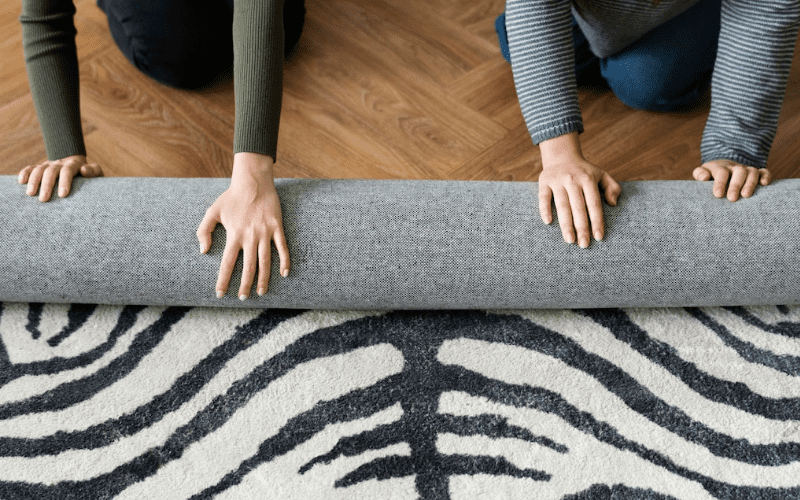Whether you want to keep your old carpet or replace it, there are a few steps to follow in order to successfully install a new carpet. Most of the time when we’re installing new carpet, we have an existing flooring surface such as ceramic tiles or hardwood floors that needs to be checked before installing new carpet. Carpets can also be installed over level with the floor tiles (like marble) so there aren’t any gaps between them. There are several ways that this can be accomplished. Here are a few tips on how to install a carpet over tiles:
Floor Prep
Before you begin, it is important to make sure that your floor is in good shape. If there are any cracks in the tile or grout, they will need to be repaired before laying new carpet over them. Also, if you have a large area of hardwood floors and only want to install carpet in one room. It is recommended to use an adhesive-backed rug pad under all four corners of your new carpet. In order to prevent any movement between the two surfaces.
You may also want to consider sealing your hardwood floors before installing new carpeting. So that moisture doesn’t get trapped underneath them later on down the road (especially if you’re using latex glues). This can help prevent warping/staining/mildew problems later down the line. When humidity rises or spills occur while walking around barefoot on top of dampened subfloors after vacuuming off dust particles from freshly laid carpets during the initial installation process (this goes double if working with wood species such as oak).
Cutting
First, you’ll need to make sure that you have the right tools for the job. You’ll want to invest in a sharp knife and straight edge (or serrated if you don’t have one). Next, carefully measure the room before cutting any carpet. It’s important that your measurements are accurate. So that your finished product looks professional and doesn’t leave any gaps between tiles or walls.
Once these steps are complete, it’s time to cut! Make sure that all edges are straight by using either a straight-edge tool or a serrated knife if necessary.
Glue Down or Glue-Less
The two main methods for installing carpet over tiles are glue down and glueless.
Glue down is the most common method, but it’s not without its drawbacks. The adhesive used to adhere the carpeting to the floor can be messy and hard on your hands. Not to mention that there may not be enough room for you to lay out all of your new carpets in one piece. Plus, if you ever want to remove or replace your flooring in the future (and who doesn’t?). Then this type of installation isn’t going to help much at all!
So what’s better? Glue-less installations allow you more freedom when installing new floors because they don’t require any adhesives or tapes during installation. Instead, they rely on tackless strips that hold down each row of tiles individually as they’re laid out on top of each other. This makes them easier than traditional methods while still giving them strength against heavy traffic areas within homes. So families can feel comfortable walking around barefoot without worrying about getting tripped up by loose pieces floating around underfoot!
Staples or Nails
If you’re going to install carpet over tile, the easiest method is to use staples. This is a good choice for large areas that require multiple rows of nails or tacks. Glue is another option that can be used on large surfaces and can be applied with a roller or brush. It’s best suited for flat surfaces but will not hold up well in high-traffic areas where there may be some movement or shifting of the flooring underneath your new carpeting over the tiles installation project.
If you want something more permanent than gluing down your new floor covering, nails are probably going to give you better results overall because they’re stronger than either glue or staples alone (although they do require some skill).
- Anime Rugs
- Modern Rugs
- Cartoon Rugs
- Outdoor Rugs
Seams or Tackless
Seams should be placed in a way that minimizes the amount of carpet needed. This means that seams should be placed where they are least visible, such as under beds and couches. These should be perpendicular to windows and doors so that they don’t create an awkward line when viewed from outside the house. In general, seams should be placed in the middle of doorways rather than at either end because it makes it easier for people to walk through without getting caught on them or tripping over them (especially if you have pets).
If you’re renting, or if you have pets or children and want to avoid the hassle of cleaning up carpet tacks, tackless is a good option. Tackless carpet also tends to hold up better than other types of carpeting in high-traffic areas like hallways or bedrooms.
Conclusion
Installing carpet over tile is a great way to give your home a fresh look and feel, without having to rip up the old flooring. As carpet won’t be damaged by moisture like wood or laminate floors can be. This makes it perfect for bathrooms, kitchens, and other wet areas. If you’re looking for ways to add some style and comfort to your home without breaking the bank, consider installing carpet over the tile! Call +86 13613866590 to book your order now.

